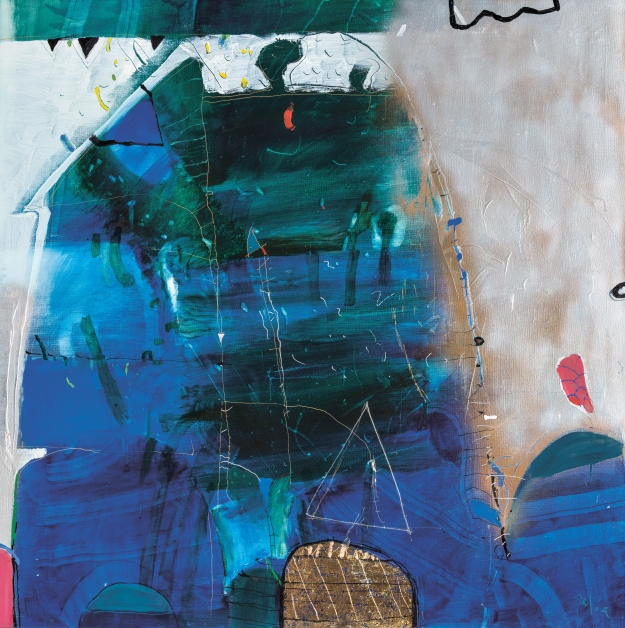Chaos is precise like a Swiss watch
Sometimes it seems to me that abstraction is the most naked type of painting of all. There is no plot or narrative there to hide behind and all the power lies with the colour, line, and hand move, and through this the subcutaneous being of a human is revealed. I am now talking about the abstractions through which Dalia Kasčiūnaitė (b. 1947) sees the world and expresses her inner state.
UždarytiThis painting has no title. It was created in 1988 during the period of intensive creative search and self-anchoring in the creative life of the artist. At that time Kasčiūnaitėwas especially interested in ecclesiastical art and studied icons. Ten years later, in 1998, she held her solo exhibition at the Contemporary Art Centre titled ‘Yellow Room. Rains’. It was then that Kasčiūnaitėhinted: ‘In general I am a very chaotic person, but my chaotic system operates precisely like a Swiss watch. Being operational and active…and having a joyride is simply indispensable to me.’This sounds almost like a moto of a creative life that is soaked with personal experience.
Most probably, the structure of this work also emerged through a spontaneous chaos. It looks like the artist made a lot of sketches and drafts before creating this previously unseen semblance. The work is untitled, because there is no way to give a name to a unique becoming of a soul and a wordless silence of a process.
Kasčiūnaitė distanced herself from heavy layers of paint and swampy dreariness and discovered a fabric which cannot be mistaken for anything else but the so-called Dalia’s fabric. It is full of vibrant spots of bright colour and precision needlework that sews together space and surface.
Otherwise, the painting is full of everything: blue spree patterned with constructivist-like geometry, sky, water and distance which are both shallow, translucent and emerald deep all at the same time. There is also a monumental construction or a creature the divine nature of which is hinted at by the golden fragment at the edge that takes us inside and retreats into itself right away. Chromatic volumes are besieged by graphic symbols and immaterial particles that look like butterflies and make the setting more specific. Here, symbols are being born imperceptibly and insecurely, because in the empirical process of layering paint and adjusting colour the image turns into an epic fiction which is both realistic and real.
Such a work could have been born out of Kasčiūnaitė’s freedom to decide and create in line with her nature by at the same time improving and chiselling her own style. The artist must have had really wise teachers who provided her with solid basics and showed the artist the right direction in her creative life. In 1972, Kasčiūnaitėgraduated from the State Institute of Art of LSSR (currently Vilnius Academy of Arts) where she was taught painting by Bronislava Jacevičiūtė, Algirdas Petrulis, Silvestras Džiaukštas, and Jonas Švažas. But the painting that is being discussed here is miles away from her first generalised landscapes and compositions demonstrating traces of subconscious symbolism and becoming more and more abstract with time.
Kasčiūnaitė distanced herself from heavy layers of paint and swampy dreariness and discovered a fabric which cannot be mistaken for anything else but the so-called Dalia’s fabric. It is full of vibrant spots of bright colour and precision needlework that sews together space and surface.
This authentic style of painting makes this classic of Lithuanian painting stand out both among her abstractionist fellow-countrymen, who are famous for their impasto weights or minimalist reduction, and representatives of the European poetical lyrical abstractionism, which Kasčiūnaitė could be conditionally attributed to for her sensuous colour. This type of painting was born right after World War II in occupation- and collaboration-ridden Paris with Wassily Kandinsky’s discoveries being a vivid example of that. It came back with renewed force in the 1970s as a reaction to minimalist or geometric (cold) abstraction and once again widely opened the door to subjective personal expression and painterliness.
All these artists have their own distinctive personal way of expression, just like all people have their own inner demons and dreams. Some of them splash with impulses and others strategically and consistently strive for their own goals. In this context Kasčiūnaitė has discovered her original artistic touch: her own balance between storm and discipline. She is not afraid of searching for the ‘great beauty’and indulging in the vertigo of feelings and colour.


